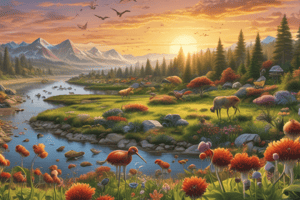Podcast
Questions and Answers
What does the variable dN/dT represent in population dynamics?
What does the variable dN/dT represent in population dynamics?
- The intrinsic growth rate of a population
- The carrying capacity of a habitat
- The total population size at a specific time
- The change in population size over time (correct)
If dN/dT is less than 0, what can be inferred about the population?
If dN/dT is less than 0, what can be inferred about the population?
- The population is unaffected by external factors
- The population is decreasing (correct)
- The population size is constant
- The population is increasing
How do small-bodied species typically portray their population dynamics?
How do small-bodied species typically portray their population dynamics?
- They have shorter life cycles and higher reproductive rates (correct)
- They are heavily reliant on abiotic factors for survival
- They grow at a slower rate due to resource limitations
- They exhibit a decline at high density environments
What factor primarily influences small-bodied species during population fluctuations?
What factor primarily influences small-bodied species during population fluctuations?
What is the consequence of an increase in deer populations on ticks?
What is the consequence of an increase in deer populations on ticks?
Which of the following statements is true regarding high density populations of small-bodied species?
Which of the following statements is true regarding high density populations of small-bodied species?
What effect does a decrease in coyote populations have on fox populations?
What effect does a decrease in coyote populations have on fox populations?
What is the relationship between acorn quantities and white-footed mice populations?
What is the relationship between acorn quantities and white-footed mice populations?
What is the primary consequence of a lack of proton gradients in ATP production?
What is the primary consequence of a lack of proton gradients in ATP production?
Which adaptations can help plants prevent herbivory?
Which adaptations can help plants prevent herbivory?
How does the presence of the drug mentioned affect postsynaptic receptors?
How does the presence of the drug mentioned affect postsynaptic receptors?
What is produced during the light-dependent reactions of photosynthesis?
What is produced during the light-dependent reactions of photosynthesis?
How does closing the stomata affect photosynthesis?
How does closing the stomata affect photosynthesis?
What hinders populations that rely on less nutritious food sources?
What hinders populations that rely on less nutritious food sources?
What is a significant result of energy loss at each trophic level in an ecosystem?
What is a significant result of energy loss at each trophic level in an ecosystem?
What role do neurotransmitters play in chemoreception and synaptic transmission?
What role do neurotransmitters play in chemoreception and synaptic transmission?
What primarily influences the density of tick populations?
What primarily influences the density of tick populations?
During which phase of thermogenesis do brown fat cells use many mitochondria to produce heat?
During which phase of thermogenesis do brown fat cells use many mitochondria to produce heat?
How does the surface area to volume ratio affect smaller organisms in terms of temperature regulation?
How does the surface area to volume ratio affect smaller organisms in terms of temperature regulation?
What is defined as the biotic and abiotic components of an area?
What is defined as the biotic and abiotic components of an area?
What happens to the moose population when the wolf population declines?
What happens to the moose population when the wolf population declines?
What effect does an herbicide blocking the electron transport chain have on photosynthesis?
What effect does an herbicide blocking the electron transport chain have on photosynthesis?
What occurs in respiration when the electron transport chain is inhibited by an herbicide?
What occurs in respiration when the electron transport chain is inhibited by an herbicide?
Which of the following factors could account for differences in moose populations?
Which of the following factors could account for differences in moose populations?
What is the role of acetylcholine in the synaptic cleft?
What is the role of acetylcholine in the synaptic cleft?
What initiates an action potential in the nervous system?
What initiates an action potential in the nervous system?
How do cochlear implants function?
How do cochlear implants function?
What must occur for separate sensory systems to perceive different sensations?
What must occur for separate sensory systems to perceive different sensations?
What occurs during the refractory period of a neuron?
What occurs during the refractory period of a neuron?
What type of receptor would respond to mechanical sensations such as sound waves?
What type of receptor would respond to mechanical sensations such as sound waves?
What physiological change occurs when stereocilia bend in response to sound?
What physiological change occurs when stereocilia bend in response to sound?
What is adaptation in the context of sensory perception?
What is adaptation in the context of sensory perception?
What is the correct order of sensory perceptions in animals?
What is the correct order of sensory perceptions in animals?
Which of the following best describes the Trophic Cascade Hypothesis?
Which of the following best describes the Trophic Cascade Hypothesis?
Which statement accurately describes chemically-gated channels?
Which statement accurately describes chemically-gated channels?
Why do wolves prefer to live in larger packs despite less available food?
Why do wolves prefer to live in larger packs despite less available food?
Which group of organisms can be classified as photoautotrophs?
Which group of organisms can be classified as photoautotrophs?
What is the defining characteristic of prokaryotes?
What is the defining characteristic of prokaryotes?
In Fick's Law, what does the variable 'D' represent?
In Fick's Law, what does the variable 'D' represent?
Which structure is the most inclusive level of organization in the context of plant anatomy?
Which structure is the most inclusive level of organization in the context of plant anatomy?
What occurs when an antibiotic is applied to a bacterial population?
What occurs when an antibiotic is applied to a bacterial population?
What is a key factor for evolution to occur according to natural selection?
What is a key factor for evolution to occur according to natural selection?
What role do mutations play in a population's evolution?
What role do mutations play in a population's evolution?
Why are pathogens often more virulent in new hosts?
Why are pathogens often more virulent in new hosts?
Which statement accurately describes genetic drift?
Which statement accurately describes genetic drift?
What does 'Survival of the Fittest' refer to in biological terms?
What does 'Survival of the Fittest' refer to in biological terms?
What happens during the founder effect?
What happens during the founder effect?
What is the significance of gene flow in a population?
What is the significance of gene flow in a population?
Flashcards
Trophic Cascade
Trophic Cascade
The effect of altering the population of a top predator on the lower trophic levels in an ecosystem.
Brown Fat
Brown Fat
Type of fat tissue that generates heat by burning energy.
Surface Area to Volume Ratio
Surface Area to Volume Ratio
The ratio between the surface area of an organism and its volume.
Hyperpolarization
Hyperpolarization
Signup and view all the flashcards
Action Potential
Action Potential
Signup and view all the flashcards
Ecosystem
Ecosystem
Signup and view all the flashcards
Herbicide (ETC Inhibitor)
Herbicide (ETC Inhibitor)
Signup and view all the flashcards
Proton Gradient Formation
Proton Gradient Formation
Signup and view all the flashcards
dN/dT
dN/dT
Signup and view all the flashcards
r
r
Signup and view all the flashcards
N
N
Signup and view all the flashcards
Exponential Growth
Exponential Growth
Signup and view all the flashcards
Small-Bodied Species
Small-Bodied Species
Signup and view all the flashcards
Density-Independent Factor
Density-Independent Factor
Signup and view all the flashcards
Abiotic Factors
Abiotic Factors
Signup and view all the flashcards
Carrying Capacity
Carrying Capacity
Signup and view all the flashcards
Acetylcholine (ACh)
Acetylcholine (ACh)
Signup and view all the flashcards
Depolarization
Depolarization
Signup and view all the flashcards
Stereocilia
Stereocilia
Signup and view all the flashcards
Cochlear Implant
Cochlear Implant
Signup and view all the flashcards
Mechanoreception
Mechanoreception
Signup and view all the flashcards
Sensory Receptors
Sensory Receptors
Signup and view all the flashcards
Refractory Period
Refractory Period
Signup and view all the flashcards
Adaptation
Adaptation
Signup and view all the flashcards
Transduction (in animal sensory perception)
Transduction (in animal sensory perception)
Signup and view all the flashcards
Photoautotroph
Photoautotroph
Signup and view all the flashcards
Monophyletic Group
Monophyletic Group
Signup and view all the flashcards
Chemically-Gated Channel
Chemically-Gated Channel
Signup and view all the flashcards
Trophic Cascade Hypothesis
Trophic Cascade Hypothesis
Signup and view all the flashcards
Tertiary Consumers
Tertiary Consumers
Signup and view all the flashcards
Emphysema
Emphysema
Signup and view all the flashcards
Reception (in animal sensory perception)
Reception (in animal sensory perception)
Signup and view all the flashcards
Genetic Drift
Genetic Drift
Signup and view all the flashcards
Random Events
Random Events
Signup and view all the flashcards
Founder Effect
Founder Effect
Signup and view all the flashcards
Antibiotic Resistance
Antibiotic Resistance
Signup and view all the flashcards
Fitness
Fitness
Signup and view all the flashcards
Natural Selection
Natural Selection
Signup and view all the flashcards
Gene Flow
Gene Flow
Signup and view all the flashcards
Evolution
Evolution
Signup and view all the flashcards
Study Notes
Biology Exam - Unit 1
-
Population Growth: Population growth is measured by dN/dT, the rate of change in population size over time. A positive dN/dT indicates increasing population, a negative dN/dT decreasing population, and a zero dN/dT indicates a stable population. Intrinsic growth rate (r) is the rate at which individuals reproduce in a population.
-
Small-Bodied Species: Characterized by high reproductive rates and lower resource demands, leading to rapid population growth and high densities. They are often density-independent, less impacted by carrying capacity. Abiotic factors, like weather changes, play a major role in their population fluctuations.
-
Density-Dependent vs. Density-Independent Factors: Density-independent factors (e.g., weather events) affect population size regardless of population density. Density-dependent factors (carrying capacity) are influenced by population density.
-
Trophic Interactions: Changes in one population (e.g., decrease in coyotes) affect other populations in a food web (e.g., increase in foxes, decrease in mice).
-
Global Climate Drivers: Natural occurrences like Milankovitch cycles, solar intensity variations, and volcanic eruptions have influenced Earth's climate throughout history.
-
Mutualistic Relationships: Organisms benefit each other (e.g., the small intestine and bacteria).
-
Homeostasis: The ability to maintain stable internal conditions despite external changes.
-
Mouse as Reservoir for Lyme Disease: Mice are primary reservoirs for the bacteria causing Lyme disease.
-
Evolutionary Relationship: Species are organised based on populations, communities, ecosystems, and biospheres.
-
Ectotherms: Organisms that regulate their body temperature by environmental conditions.
Biology Exam - Unit 2
-
Action Potentials: Neural signal transmission involves changes in membrane potential (depolarization, repolarization). Ion channels are crucial for these processes.
-
Trophic Cascades: Changes in predator populations affect prey populations and the broader ecosystem.
-
Plant Responses to Herbicides: Herbicides can disrupt electron transport chains, which in turn affect ATP production.
-
Energy Requirements (Predicting Population Numbers): Calculating the number of organisms a specific amount of resources can support.
-
Light-Dependent Reactions: The light-dependent reactions of photosynthesis produce ATP and NADPH, which are essential for the light-independent reactions.
-
Adaptations to Prevent Herbivory: Plants adapt by producing spines, producing bad-tasting chemicals, attracting predators of herbivores, or growing in harsh environments.
-
Hawk & Biomass: High trophic levels (consumer organisms) have less biomass than lower trophic levels (producers).
Biology Exam - Unit 3
-
Prokaryotes vs. Eukaryotes: Prokaryotes lack nuclei and membrane-bound organelles; eukaryotes have these features.
-
Fick's Law of Diffusion: Describes the rate of gas exchange (rate of diffusion) by considering factors like surface area, partial pressure difference, and the diffusion distance.
-
Alveoli Differences: Emphysema (alveoli merge, leading to less surface area) and pneumonia (fluid accumulation in alveoli) result in varying gas exchange efficiency.
-
Biological Species Concept: A group of interbreeding organisms isolated reproductively and produces fertile offspring. Useful example: frog species.
-
Evolutionary Theories: Evolution is supported by scientific evidence. "Survival of the fittest" is a simplified representation of reproductive success.
Biology Exam - Unit 4
-
Evolutionary Theory: Evidence supports evolution over time and adaptation to changing environments.
-
Myxoma Virus & Rabbit Populations: The virus's virulence initially decreased rabbit populations, but the rabbits evolved resistance.
-
Gene Flow: Genetic exchange between populations changes gene variations.
-
Genetic Drift: Random changes in allele frequencies.
-
Natural Selection: Selection for favorable traits and its effect on population variation.
-
Hardy-Weinberg Equilibrium: A condition where allele frequencies are stable in a population.
-
Lyme Disease Cause: A bacterial infection.
Studying That Suits You
Use AI to generate personalized quizzes and flashcards to suit your learning preferences.




